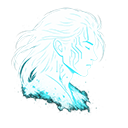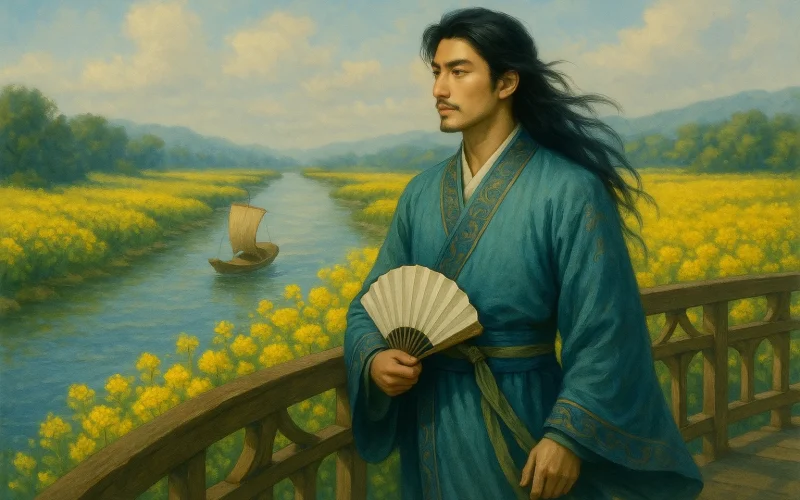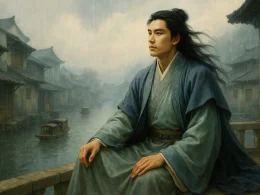Cui Dong (崔峒, dates of birth and death unknown), a Tang Dynasty poet from Anping, Hebei, was active during the Dali era (766-779). Along with Sikong Shu, Lu Lun and others, he was known as one of the "Ten Talents of Dali." His poetry primarily consists of five-character regulated verse (wulü), characterized by an elegant and subtle style. The Complete Tang Poems preserves 48 of his works. His poetic style resembles Liu Changqing's but appears more solitary and austere, reflecting the transition from the vigorous grandeur of High Tang poetry to the introspective quality of Dali-era verse.
Major Works
Life Overview
Cui Dong's birth and death years are unknown, and his ancestral origin is disputed. One theory suggests he was from Boling (modern-day Anping, Hebei), belonging to the prestigious Tang dynasty aristocratic clan, the "Boling Cui Family." Another theory points to Qinghe (modern-day Qinghe, Hebei). He passed the imperial examinations in his early years and held positions such as Lufu Gongcao (潞府功曹) and Right Bujue (右补阙), later advancing to the rank of provincial governor (Cishi, 刺史). However, due to a lack of historical records, the specific prefectures he governed and details of his later life remain unclear.
Cui Dong was active during the Mid-Tang period following the An Lushan Rebellion (755–763). Alongside Qian Qi, Lu Lun, Han Hong, Sikong Shu, and others, he was recognized as one of the "Ten Talents of the Dali Era" (大历十才子). This group of poets primarily engaged in literary exchanges, farewell poems, and depictions of reclusive landscapes, their style shifting from the boldness of the High Tang to a more introspective and subdued tone, reflecting the melancholy of scholars in turbulent times. Cui Dong’s social circles were concentrated among the bureaucratic literati of Chang’an and Luoyang, where he often composed poems for influential figures to seek career advancement—a common survival strategy for Mid-Tang intellectuals amid political instability.
Although Cui Dong did not directly experience the most brutal phases of the An Lushan Rebellion, his formative years unfolded during its aftermath, marked by social devastation and widespread suffering. This historical backdrop infused his poetry with themes of wandering, separation, and sorrow. His official career was likely unremarkable, and he gradually faded from historical records, leaving behind only a few dozen poems preserved in later compilations such as the Complete Tang Poems (全唐诗).
Literary Achievements
As one of the "Ten Talents of the Dali" Cui Dong’s literary contributions primarily reside in his poetry. Although fewer than fifty of his works survive, they hold a distinct place in Mid-Tang literary circles. His poetry embodies the shared characteristics of the Dali poetic style while also displaying unique personal artistry in both expression and emotional depth.
Themes in Poetry
Cui Dong’s works mainly fall into three categories: landscape and pastoral poetry, travel laments, and social exchange poems. His nature poetry often incorporates Zen Buddhist undertones, as seen in "Inscribed on Chongfu Temple" (《题崇福寺禅院》), where he depicts monastic life and the temple’s tranquil surroundings to craft an ethereal, meditative atmosphere. His travel poems frequently convey the sorrows of displacement in a fractured era—for example, "Reflections on the River" (《江上书怀》) uses plainspoken language to express the anguish of exile with poignant sincerity. His social poems, such as "Farewell to Assistant Wei on His Return to the Eastern Capital" (《送韦八少府判官归东京》), retain the conventions of farewell poetry while infusing them with the Mid-Tang’s characteristic desolation.
Artistic Merits
In terms of artistic achievement, Cui Dong’s poetry is marked by elegant yet natural language and a preference for unembellished description over excessive allusion. He excels in weaving imagery to construct mood, such as in "A clear chime pierces emerald mountains; / Idle clouds drift to the bamboo chamber" (《题崇福寺禅院》), where he evokes the temple’s serenity, or "The old courier station frost-laden, / Persimmon leaves shiver in the cold" (《送韦八少府》), which underscores the bleakness of parting. Emotionally, his works embody the introspection typical of Dali poets, often embedding profound sentiment beneath seemingly placid scenes, resulting in a subtle, layered aesthetic.
Though Cui Dong’s poetry lacks the grandeur of the High Tang, it demonstrates mastery in diction and atmosphere. Ming dynasty critic Hu Yinglin (胡应麟) remarked in Shi Sou (《诗薮》) that his verses were "somewhat lacking in vigor but naturally serene in spirit." The Siku Quanshu Zongmu Tiyao (《四库全书总目提要》) of the Qing dynasty also praised his poetry as "lacking in majesty yet refined and readable," affirming his skill in linguistic precision. These evaluations indicate that while Cui Dong may not rank among the foremost poets, his works possess a unique artistic value within Mid-Tang literature.
Detailed Analysis of Poetic Style
1. Language: Simplicity and Conciseness
- Use of short phrases and imagery clusters, such as "A clear chime pierces emerald mountains; / Idle clouds drift to the bamboo chamber" (《题崇福寺禅院》), blending sound (chime), color (emerald), and motion (drifting clouds) into a cohesive scene.
- Minimal reliance on allusions, favoring straightforward expression—e.g., "After climbing high, I turn back— / Only my shadow follows" (《江上书怀》).
2. Atmosphere: Solitude and Subtlety
- Zen-infused tranquility: Influenced by the Mid-Tang’s Buddhist revival, his poems feature motifs like "empty mountains," "lonely clouds," and "cold temple bells." The line "No man—only the setting sun’s void" (《题崇福寺禅院》) intensifies the sense of isolation.
- Nature as emotional closure: Many poems conclude with lingering natural imagery, leaving unspoken melancholy—e.g., "The old courier station frost-laden, / Persimmon leaves shiver in the cold" (《送韦八少府》).
3. Emotion: Restraint and Nuance
- Implied sorrow: Unlike the High Tang’s direct emotionality, Cui Dong’s grief is veiled—e.g., "How many mountains have parted us now?" (《酬李补阙雨中寄赠》) hints at separation through understatement.
- Mid-Tang introspection: His travel poems reveal trauma through subtle details—white hair ("silken threads in the mirror") or tears ("blood-streaked weeping")—symbolizing unvoiced despair.
Legacy
Cui Dong, a mid-tier scholar of the Dali period, may not have left an extensive body of work, but his refined language, restrained lyricism, and Zen-like serenity make his poetry a representative sample of Mid-Tang literary transition. Studying his verses provides insight into the spiritual world and artistic pursuits of post-rebellion intellectuals.






















